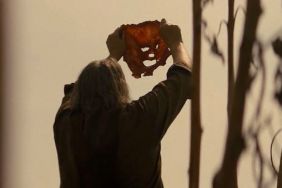A teenager is running, crying, trying to hide from a killer. The killer has already murdered her friends over the course of the last few evenings, and she is in a panic. The killer seems to be supernatural in his ambition. He seems capable of withstanding all kind of horrible physical attacks, and still manages to stand back up, take up a knife, and continue his bloody rampage. Clearly this man is not concerned with being apprehended or being talked out of his task. He will commit murder. What is his identity? We do not know. Only his victims have seen his face, provided he’s not wearing a mask. The young woman our killer is after was always the least interesting person in her peer group, preferring to cleave closer to books and babysitting jobs than to parties, drink and coitus. She is scared, but resolute and resourceful, and has a plan to perhaps knock out or kill her stalker before she is herself murdered. The first plan didn’t work, sadly, and she’s onto a new plan. How is it, she begins to wonder, that he got up after I killed him?
Quickly: What film did I just describe?
If you said Halloween, you’d be right. But I also would have accepted any of about 100 titles that description would have also matched.
Welcome, fright fiends, to a special Halloween edition of CraveOnline’s Free Film School, the only film school where you get more than your money’s worth. It’s also probably one of the only film schools in the country that will devote a special lesson to today’s topic: The history of the slasher film. I will not only take you through the early days of the genre, and watch how it has grown over the years, but I will try to offer what critical commentary I can.
Slasher Films are a well-known genre to anyone who grew up in the 1980s, and are probably familiar to kids of the ‘90s through cultural osmosis. The 1980s was kind of the heyday of the genre, although it still lives on to this day in occasional theatrical releases, and having influenced all the young filmmakers of the day. And while there are only a few slashers that can be considered legitimate film classics, they, as a whole, seem to occupy an enormous corner of the cinematic canon. Slashers, I would say, constitute the bulk (at least 51%) of all horror films released after 1978. And while some manage to tap deeply into the fears of the culture, and can actually serve to disturb and chill and explore the deeper, darker recesses of the human imagination, most only manage to be silly gore exercises, encouraging the (no doubt) teenage audience to gleefully cheer the violent mayhem, and to take sides with the film’s charismatic, bloodthirsty killer, instead of his screaming victims.

Horror films have been around as long as the medium. Indeed, many snotty critics (like myself) often cite F.W. Murnau’s film Nosferatu as one of the scariest ever made, and that was released in 1922. Our preoccupation with death in film is widespread (as I explored in last week’s lesson), so it only makes sense that horror films should remain ubiquitous over film’s history. However, unlike the films with vampires, monsters, or other more classical, literature-based killers, the slasher film was likely influenced by a rising visibility in real-life serial killers. And while history and literature are rife with people who liked to commit murder as a hobby (Jack the Ripper comes to mind, as does Raskolnikov from Crime and Punishment), it wasn’t until the mid-20th century that news reports of serial killers became common.
The first high-profile real-life killer in America was probably Ed Gein, a man from Wisconsin who killed a few women in the mid-1950s, and who liked to exhume human corpses to fashion trinkets from their bones. There was also the famed 1957 event of the Clutter family being murdered in their Kansas home, as detailed at length in Truman Capote’s 1966 book In Cold Blood. From there, images of Gein’s horrific crimes, and the bloody night of the Clutters, leaked into the imaginations of screenwriters, and movies about series killers began to appear in theaters.

In 1960, a British film director named Michael Powell made the film that is often cited as one of two important proto-slashers. His film was about a fey and intelligent film-obsessive (Carl Boehm) and his fascination with capturing the moment of human death on film. He would film women he had lured back to his apartment, and stab them with the tripod of his camera, filming them as their life left their bodies. The film is called Peeping Tom, and is one of the better and more disturbing psychological horror films ever made. That same year, Alfred Hitchcock, using his low-budget crew of TV cameras, made Psycho, a gleefully lurid tale of a serial killer’s personal habits, and one of the most famous movies ever, not least of which for its famous narrative “left turn” halfway through the movie. If you know little about Psycho, I won’t ruin any of the surprises, and I will implore that you see it immediately. Thanks to movies like this, and the increased visibility of other real-life criminals. The public’s imagination became whetted for more lurid tales of people killing people.
By the 1970s, stories of serial killers began to appear regularly in grindhouses and drive-in movies. They had everything exploitation movies needed. Blood, violence, twisted psychology, and, often, a link to sexual matters. They all purported to be based in real psychology, but most serial killer movies of the ‘70s were an excuse to show mayhem, or, at the very least, cool-ass grizzled cops seeking to end the mayhem. It was during this time that America was treated to a vast influx of Italian horror movies, referred to today as “giallo” movies. Giallo is such a vast genre unto itself, however, that it will warrant its own lesson someday. Suffice it to say for now that giallo films (or gialli, as a plural) are all pulp crime films, usually laced with a very particular brand of Italian campiness. It was also during this time that Tobe Hooper, working with a limited budget, made the gritty and gross Ed Gein-inspired film The Texas Chainsaw Massacre. Thanks to the popularity of this wonderfully sick little film, killers in movies mutated from real-life sex-obsessives into bloodthirsty superhuman monsters. Odd that our serial killers moved from monsters to real-life humans back to monsters. These days, films to feature serial killers are often referred to as “thrillers” and not as horror movies.

The first film that could be described as what we call a slasher film is Bob Clark’s 1974 film Black Christmas, starring Olivia Hussey and John Saxon. It was Black Christmas that would serve to codify all the usual clichés and patters usually associated with the genre. A group of young people, usually in their teens or early 20s. A hidden killer who waits for them to be alone, and then kills them in their solitude. A killer who cannot be reasoned with. A killer whose identity is either hidden or mysterious is some fashion. Creative kills (a slasher, as the name implies, will most often use cutting tool or knives; guns are right out). And while Black Christmas was technically the first of the genre, it still teeters on the ledge between legit horror and grizzled crime procedural. The real flagship of the slasher genre – the one that most people cite when they refer to “the first” – is John Carpenter’s 1978 film Halloween. Halloween is not only the first proper slasher film, but also the one that achieved enough popularity to perpetuate this new form of horror that was still “finding its feet,” so to speak. Halloween told the story of a madman, named Michael Myers, who escaped from a local Illinois mental asylum and returned to his childhood home on Halloween day. Michael, never speaking, and wearing a blue workman’s jumpsuit and a pilfered Halloween mask, spent the length of the film stalking and occasionally killing the teenagers in his neighborhood. The only one to become savvy to what Michael was doing was the virginal Laurie Strode (Jamie Lee Curtis, in her first film role), and who would eventually be the one to deflect his attacks. Michael’s shrink, Dr. Loomis (Donald Pleasance) would spend most of the film trying to convince the local authorities that his patient is indeed dangerous. I can’t imagine too many of you haven’t seen Halloween, but if you haven’t it’s all I can do to encourage you to see it as soon as you can. Brutal, slick, terrifying, and still fresh, despite the hundreds of imitators, Halloween is one of the best horror movies ever made. It was also one of the most successful movies in film history, having made about $60 million on its mere $320,000 budget.

From there, Hollywood studios saw the lucrative opportunities, and slasher films began to spring up like weeds. The entire decade of the 1980s were really the vast glory days of the slasher film, featuring sexually promiscuous teenagers being hacked down by masked killers of all stripes. It was during this era that all the important and famous slashers made their first appearances. Friday the 13th was released in 1980. A Nightmare on Elm Street in 1984. Hellraiser in 1987. Child’s Play in 1988. If you count just the sequels (and not the remakes) of Halloween and the films I just mentioned, you have 34 movies to get through. Get cracking.
Here’s an important question regarding slashers: Are the killers secretly altruistic? A noticeable pattern in most slasher films is that the teenage victims tend to be amoral hedonists, who often indulge in drink, drugs and sex. The most vice-ridden teens tend to be the ones who are cut down first, or at least most brutally. True, the killers are murderers, but in an odd way they have been cast as punitive angels of death. The early slashers may be seen as a comment on the youth-gone-wild concerns of older audience members. But then if the killer is the one to be identified with, and not the victims, perhaps the slashers are a more chilling comment on the amoral attitudes of the audience, revealing equally hateful anti-sex, anti-woman (women are frequently victims; indeed more often than men), and ambivalently violent attitudes. In later films, like Saw, the altruism of the killer is focused upon. In others, though, like some of the more-brutal remakes, the violence is focused upon. Which camp is more appropriate for horror? Which do you prefer? Which famed movie killer has the best attitude? Is that a weird question to ask?

It was also during the 1980s that the Gorehound began to surface. As the number of horror films increased, and the special effects used therein became more sophisticated and bloody, so too did the number of genre fans. Indeed, it was in 1979 that Fangoria magazine hit the shelves, providing a periodical for the people interested in blood and eviscerated body parts made of latex. It created a community of outsider fans the likes of which the world had rarely seen outside of Star Trek conventions. It was in communities like this that fans began to compare notes, and the “rules” for slasher films became even more sternly codified. The notion of the altruistic killer, the rules as to whom would be killed first, the creativity of different killers’ different kills, these were all openly discussed with a newfound nerdy enthusiasm. Fangoria, to this day, occupies a powerful and old-time elder statesman spot within geek culture. By the late 1980s, Fangoria was riding high, the horror sequel was an institution, and slasher films seemed to come out every other week. I personally remember this time, and was drawn to the scary images in the newspapers, but, being a young child, was always too scared to go to see the movies.

By the 1990s, the genre started to be seen as played out. Horror films during the early ‘90s became increasingly high-concept (1992’s The Silence of the Lambs seemed to offer the last word on the topic of serial killers), and traditional slashers fell by the wayside. It wasn’t until 1996 that anything significant would happen with slashers. It was in 1996 that Wes Craven, the director of the original A Nightmare on Elm Street released Scream. Scream was a slasher film about teens who had grown up watching ‘80s slasher films, so they seemed to recognize the patterns, even as they were living them. The film was supposed to serve as a deconstruction and a dissection, and ultimately a destruction of a previous generation’s conventions. Sadly, given the way Hollywood thinks, it instead revitalized the genre, making for an entire new slew of self-referential slasher films, each to feature a film nerd. As a film nerd myself, I simultaneously appreciated the lionization and resented being boiled down into a stock character. It was during this age that ‘90s teen angst, leaking out from grunge rock, began to become the centerpiece of slasher films. The victims became thoughtful. And while this brand of moody introspection can be just as insufferable as an obnoxious, faceless victim, I think I appreciate that the victims became the center of attention again. Sometimes, when your killer is the main sympathetic character, it can make for poor drama, and a questionable moral stance.

In 1998, Gus Van Sant made a shot-for-shot remake of Alfred Hitchcock’s classic Psycho (before remakes were de rigeur), which could be seen as a death knell for the slasher genre altogether. Fitting, I suppose, that the genre should be ushered in and out with the same film.

Yes, now, over the last decade, we’ve been suffering through a run of remake after remake, making extra-violent versions of the films that were hot in the 1980s. Most every film I’ve mentioned in this essay has been remade at this point, or is slated to be remade. (Ooh… Can you picture a self-referential remake of Scream? The snake will have choked to death on its own tail at that point.) And while each can be praised or criticized on their own individual merits, I think I resent the open lack of creativity on Hollywood’s part, and its smug insertion of their new product into discussion of the classic. I understand that predictability and banality goes hand-in-glove with slashers. But with the first wave, the banality became part of the genre’s charm. There’s nothing charming about these bare-faced remakes. I feel kind of sorry for teenagers who have been raised on nothing but remakes. They do not necessarily know what made the original notable to begin with. To any young people who happen to be reading this, it’s you I am encouraging the most voluminously. Rent the classics. Don’t see the remakes. You’ll find greater rewards, greater scares, and better movies.
The popularity of slasher films – and indeed violent media in general – is a fulcrum for most debates about crime in society. The question often runs: “Does consumption of violent media desensitize youths to violence, and perhaps lead to their committing of violent acts?” This is a question that will never be properly answered, as finding objective data on such things is nigh impossible. I can say that I’ve been a gorehound my entire life, and I have murdered zero people or housepets. I know many gorehounds, and while they may be socially awkward and mean-spirited at worst, I’ve not known any of them to be killers. If the heyday of widely-consumed horror films was confined to the 1980s, and crime didn’t necessarily see any marked rise, I’d say the argument is specious. I suppose that in a home that allows young children to consume vast amounts of extreme violence, it can be gleaned that there is not much in the way of open discussions about real-life violence, and perhaps a greater tendency to see it as a game. But I digress. As was said in Scream: “Movies don’t create killers. Movies make killers creative.”
Slasher films were so plentiful – and indeed are still being made – that one could start in 1978, continue forward on home video, and not stop for a decade, and still not see everything the genre has to offer. The stabbing, the slashing, the decapitations, the nail gun killing, the head-stomping. The vast creativity of murder has exploded into a gleeful celebration of the teenage death fantasy. Slashers, for many people and for several generations, made horror films fun again. It’s fun to be scared. It’s fun to see movies with people your age in them. Slashers were a grand gift to millions of teens the world over. I prefer the old-timey slashers to any reboots or remakes, and I try to watch Halloween every October. For horror, it doesn’t get much better.
HOMEWORK FOR THE WEEK: Watch the 1978 version of Halloween. Is it better or worse than the last new horror film you saw? Watch any random horror sequel, even if you haven’t seen the original. What makes a horror film fun, and what makes it scary? When you see a killer on screen, do you relate to the victim, or do you relate to the killer? Which is a better approach? Pick up a copy of Fangoria magazine. What does it reveal about the psyche of the perceived horror fan? How do you feel about slasher movies?








